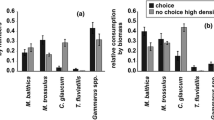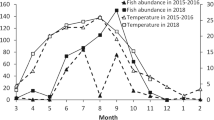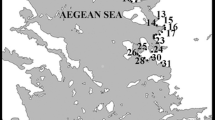Abstract
The present study was undertaken to determine whether the various species of gobies that are found within the large Swan Estuary in south-western Australia are segregated within that system, and to attempt to determine the basis for any differences in their spatial distributions. The Swan Estuary comprises a long entrance channel (lower estuary), two wide basins (middle estuary) and the saline reaches of the tributary rivers (upper estuary). A total of 26232 gobies, representing seven species, was collected using a 3 mm-mesh seine net at 15 sites throughout this estuary on at least one occasion monthly over seven consecutive seasons between September 1983 and March 1985. Favonigobius lateralis and Pseudogobius olorum contributed 47.0 and 47.8%, respectively, to the total catch of gobies at all sites. The densities of each species at each site were used to determine the relative contribution of each species to the gobiid fauna at each of the sites in the lower, middle and upper estuary. Comparisons of these data with those published on the distribution and abundance of gobiid larvae confirmed that F. lateralis, which was found predominantly in the lower estuary, is a marine species that spawns in high salinities near the estuary mouth or in inshore coastal waters. In contrast, the life cycle of P. olorum and Papillogobius punctatus are typically completed within the saline reaches of the upper estuary, and that of Arenigobius bifrenatus within both this region and parts of the middle estuary where the substrate is particularly soft. Afurcagobius suppositus also spawns in this area, as well as in fresh water. Tridentiger trigonocephalus, represented by only eight individuals, is an introduced, marine species that was found mainly in the lower estuary. A single representative of the marine species Callogobius depressus was caught. The relatively low numbers of gobies caught in the middle estuary, where they contributed only about 3.5% to the total number of all gobies at all sites, may represent an aversion to the presence of rougher waters in the large basins. Circumstantial evidence suggests that the sandy substrate and consistently high salinities found in the lower estuary are preferred by F. lateralis, whereas the silty surface to the substrate and lower salinities of the upper estuary are preferred by Pseudogobius olorum. Densities of three of the four most abundant species were higher in either spring or summer than in winter, reflecting the influx of 0 + recruits, and possibly also the tendency for species in estuaries to congregate in the shallows during the warmer periods of the year. F. lateralis fed mainly on polychaetes and crustaceans, whereas P. olorum ingested predominantly algae, reflecting differences in mouth morphology and feeding behaviour, rather than the type of food available.
Similar content being viewed by others
References
Adams, S. M. (1976). The ecology of eelgrass, Zostera marina (L.), fish communities. I. Structural analysis. J. exp. mar. Biol. Ecol. 22: 269–291
Akihito, Prince, Hayashi, M., Yoshino, T. (1984). Suborder Gobioidei. In: Masuda, K., Amaoka, C., Araga, C., Uyeno, T., Yoshino, T. (eds.) The fishes of the Japanese Archipelago. Tokai University Press, Tokyo, p. 236–289
Allen, G. R. (1982). Inland fishes of Western Australia. Perth: W. A. Museum
Ball, J. N. (1961). On the brown trout of Llyn Tegid. Proc. zool. Soc. Lond. 137: 599–622
Bascomb, C. L. (1974). Physical and chemical analyses of <2 mm samples. In: Avery, B. W., Bascomb, C. L. (eds.) Soil survey laboratory methods. British Soil Survey, Rothampsted Experimental Station Harpenden, Herts., England p. 15–17 (Soil Surv. Tech. Monogr. No. 6)
Chalmer, P. N., Hodgkin, E. P., Kendrick, G. W. (1976). Benthic faunal changes in a seasonal estuary of south-western Australia. Rec. West. Aust. Mus. 4: 383–410
Chrystal, P. J., Potter, I. C., Loneragan, N. R., Holt, C. P. (1985). Age structure, growth rates, movement patterns and feeding in an estuarine population of the cardinalfish Apogon rueppellii. Mar. Biol. 85: 185–197
Claridge, P. N., Hardisty, M. W., Potter, I. C., Williams, C. V. (1985). Abundance, life history and ligulosis in the gobies (Teleostei) of the inner Seven Estuary. J. mar. biol. Ass. U.K. 65: 951–968
Claridge, P. N., Potter, I. C., Hardisty, M. W. (1986). Seasonal changes in movements, abundance, size composition and diversity of the fish fauna of the Severn Estuary. J. mar. biol. Ass. U.K. 66: 229–258
Darcy, G. H. (1980). Comparison of ecological and life history information on gobiid fishes, with emphasis on the southeastern United States. NOAA natn. mar. Fish. Serv. tech. Memo. U.S. Dep. Commerce 15: 1–55
Day, J. H. (1981a). The estuarine fauna. In: Day, J. H. (ed.) Estuarine ecology with particular reference to Southern Africa. A. A. Balkema, Rotterdam, p. 147–178
Day, J. H. (1981b). Summaries of current knowledge of 43 estuaries in southern Africa. In: Day, J. H. (ed.) Estuarine ecology with particular reference to Southern Africa. A. A. Balkema, Rotterdam, p. 251–329
Day, J. H., Blaber, S. J. M., Wallace, J. H. (1981). Estuarine fishes. In: Day, J. H. (ed.) Estuarine ecology with particular reference to Southern Africa. A. A. Balkema, Rotterdam, p. 197–221
Geevarghese, C., John, P. A. (1983). Maturation and spawning of a gobiid fish, Oligolepis acutipennis (Cuv. and Val.), from the south-west coast of India. J. Fish Biol. 23: 611–624
Gill, H. S., Miller, P. J. (1990). A new genus and species of goby from the Swan-Avon estuary, Western Australia, with a redescription of the genus Favonigobius Whitley, 1930. Rec. West. Aust. Mus. 14: 503–525
Haedrich, R. L. (1983). Estuarine fishes. In: Ketchum, B. H. (ed.) Ecosystems of the world 26: Estuaries and enclosed seas. Elsevier, Amsterdam, p. 183–207
Halse, S. A. (1981). Faunal assemblages of some saline lakes near Marchagee, Western Australia. Aust. J. mar. Freshwat. Res. 32: 133–142
Hodgkin, E. P., Lenanton, R. C. (1981). Estuaries and coastal lagoons of south western Australia. In: Neilson, B. J., Cronin, L. E. (eds.) Estuaries and nutrients. Humana Press, New Jersey, p. 307–321
Hoese, D. F., Larson, H. K. (1980). Family Gobiidae. Gobies. In: McDowall, R. M. (eds.) Freshwater fishes of south-eastern Australia (New South Wales, Victoria and Tasmania). Reed, Sydney, p. 186–192
Hoff, J. G., Ibara, R. M. (1977). Factors affecting the seasonal abundance, composition and diversity of fishes in a southeastern New England Estuary. Estuar. cstl mar. Sci. 5: 665–678
Humphries, P., Hyndes, G. A., Potter, I. C. (1992a). Comparisons between the diets of distant taxa (teleost fish and cormorant) in an Australian estuary. Estuaries 15: 286–293
Humphries, P., Potter, I. C. (1993). Relationship between the habitat and diet of three species of atherinids and three species of gobies in a temperate Australia estuary. Mar. Biol. 116:193–204
Humphries, P., Potter, I. C., Loneragan, N. R. (1992b). The fish community in the shallows of a temperate Australian estuary: relationships with the aquatic macrophyte Ruppia megacarpa and environmental variables. Estuar., cstl Shelf Sci. 34: 325–346
Hutchins, I. B., Swainston, R. (1986). Sea fishes of southern Australia. Perth: Swainston
Hynes, H. B. N. (1950). The food of fresh-water sticklebacks (Gasterosteus aculeatus and Pygosteus pungitius), with a review of methods used in studies of the food of fishes. J. Anim. Ecol. 19: 36–58
Lake, J. S. (1971). Freshwater fishes and rivers of Australia. Nelson, Sydney
Last, P. R., Scott, E. O. G., Talbot, F. H. (1983). Fishes of Tasmania. Tasmanian Fisheries Development Authority, Hobart
Livingstone, R. J. (1976). Diurnal and seasonal fluctuations of organisms in a North Florida Estuary. Estuar. cstl mar. Sci. 4: 373–400
Loneragan, N. R., Potter, I. C. (1990). Factors influencing community structure and distribution of different life-cycle categories of fishes in shallow waters of a large Australian estuary. Mar. Biol. 106: 25–37
Lonergan, N. R., Potter, I. C., Lenanton, R. C. J. (1989). Influence of site, season and year on contributions made by marine, estuarine, diadromous and freshwater species to the fish fauna of a temperate Australian estuary. Mar. Biol. 103: 461–479
Loneragan, N. R., Potter, I. C., Lenanton, R. C. J., Caputi, N. (1986). Spatial and seasonal differences in the fish fauna in the shallows of a large Australian estuary. Mar. Biol. 92: 575–586
Miller, P. J. (1975). Age-structure and life-span in the common goby, Pomatoschistus microps. J. Zool., Lond. 177: 425–448
Miller, P. J., Fouda, M. M. (1986). Notes on the biology of a red sea goby, Silhouettea aegyptia (Chabanaud, 1933) (Teleostei: Gobiidae). Cybium 10: 395–409
Neira, F. J., Potter, I. C. (1992a). The ichthyoplankton of a seasonally closed estuary in temperate Australia. Does an extended period of opening influence species composition? J. Fish Biol. 41: 935–953
Neira, F. J., Potter, I. C. (1992b). Movement of larval fishes through the entrance channel of a seasonally open estuary in Western Australia. Estuar., cstl Shelf Sci. 35: 213–224
Neira, F. J., Potter, I. C., Bradley, J. S. (1992). Seasonal and spatial changes in the larva fish fauna within a large temperate Australian estuary. Mar. Biol. 112: 1–16
Potter, I. C., Beckley, L. E., Whitfield, A. K., Lenanton, R. C. J. (1990). Comparisons between the roles played by estuaries in the life cycles of fishes in temperate Western Australia and southern Africa. Envir. Biol. Fish. 28: 143–178
Potter, I. C., Hyndes, G. A., Baronie, F. M. (1993). The fish fauna of a seasonally closed Australian estuary. Is the prevalence of estuarine-spawning species high? Mar. Biol. 116: 19–30
Potter, I. C., Ivantsoff, W., Cameron, R., Minnard, J. (1986). Life cycles and distribution of atherinids in the marine and estuarine waters of southern Australia. Hydrobiologia 139: 23–40
Potter, I. C., Loneragan, N. R., Lenanton, R. C. J., Chrystal, P. J., Grant, C. J. (1983). Abundance, distribution and age structure of fish populations in a Western Australian estuary. J. Zool., Lond. 200: 21–50
Prince, J. D., Potter, I. C., Lenanton, R. C. J., Loneragan, N. R. (1982). Segregation and feeding of atherinid species (Teleostei) in south-western Australian estuaries. Aust. J. mar. Freshwat. Res. 33: 865–880
Spencer, R. S. (1956). Studies in Australian estuarine hydrology. Aust. J. mar. Freshwat. Res. 7: 193–250
Whitfield, A. K. (1990). Life-history styles of fishes in South African estuaries. Envir. Biol. Fish. 28: 295–308
Young, P. C. (1981). Temporal changes in the vagile epibenthic fauna of two seagrass meadows (Zostera capricorni and Posidonia australis). Mar. Ecol. Prog. Ser. 5: 91–102
Author information
Authors and Affiliations
Rights and permissions
About this article
Cite this article
Gill, H.S., Potter, I.C. Spatial segregation amongst goby species within an Australian estuary, with a comparison of the diets and salinity tolerance of the two most abundant species. Marine Biology 117, 515–526 (1993). https://doi.org/10.1007/BF00349327
Received:
Accepted:
Issue Date:
DOI: https://doi.org/10.1007/BF00349327




